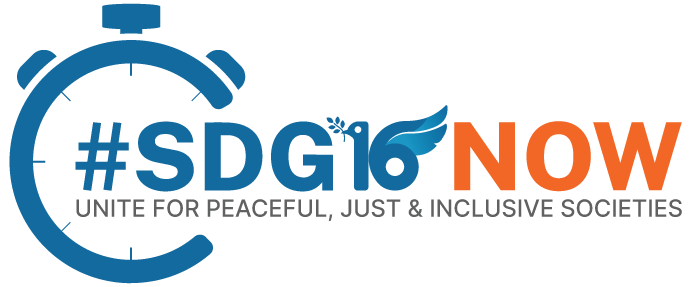Role of the SDG16 Data Initiative
The SDG16 Data Initiative is a consortium of 18 partner organisations that seeks to support the tracking of commitments made by UN Member States under SDG16, which promotes peaceful, just and inclusive societies. The 18 partners do this in different ways, an important one of which is collecting and curating high-quality, non-official data on progress towards the achievement of SDG16. They then communicate what that data shows about global progress towards this important goal and catalyse action for change based on the data. The initiative also helps identify potential challenges in data quality, availability and coverage, for both official and non-official data, and to mobilise action to address those challenges.
In addition to participating in various SDG-related events, such as the annual Rome conference on SDG16 and the annual High-Level Political Forum (HLPF) meetings in New York, the SDG16 Data Initiative also publishes an annual report on the results of its partners’ work. The title of the 2021 Report was, Impact of the pandemic on measuring progress towards SDG 16: Looking forward, tackling obstacles,1 while the 2022 Report was, Are we on track to meeting the 2030 agenda?2 In particular, this second report provides a longitudinal view of how well countries around the world are doing in terms of meeting their SDG16 commitments.
Analysis of progress towards this goal
In its 2022 Report, Are we on track to meeting the 2030 Agenda?, the SDG16 Data Initiative focused on how much progress states had made, in general, on different targets and indicators under SDG16. The Introduction to the Report makes this sobering statement:
“Overall, the analysis suggests that the international community faces very strong headwinds for meeting many of the 12 targets and 24 indicators that the UN has specified for SDG16. Throughout the report, analysts predict that it is very likely that many key indicators for SDG16 will not be reached by 2030, especially in countries experiencing democratic erosion, protracted conflict and armed violence, and unequal development.”3
If the assertions regarding the significance of SDG16 and its targets – both in their own right and as cross-cutting underpinnings for achieving all other SDGs – hold true, concerns are raised for the overall success of the SDG project. The SDG16 Data Initiative is not alone in raising the alarm about achievement of the SDGs; in September 2019, even before the advent of the COVID-19 pandemic, the UN Deputy Secretary-General publicly expressed serious concerns about how far behind the world was on achieving the SDGs, noting: “At the current rate of investment, it will be impossible to achieve the SDGs by 2030. This is bad for people, bad for society, bad for the environment and bad for business.”4
One of the challenges with the SDGs in general, but again perhaps more significant under SDG16, is the lack of any clear definition of what the actual objective is. The UN set a very vague standard for achievement of all the SDGs, namely ‘substantial progress’.5 Some indication of what might constitute this may be gleaned from the standards the UN Statistics Division used for one of the three indicators under SDG16 that it assessed in 2022. This was Indicator 16.a.1: “Existence of independent national human rights institutions in compliance with the Paris Principles”, where it suggested that 75 per cent of all countries would be required to merit a ‘target met or almost met’ rating.6 However, given that the SDGs are supposed to assess progress, it would be necessary to look at how many countries had such institutions in 2015 and what degree of progress 75 per cent would therefore represent.
Global progress towards SDG16
The 2022 SDG16 Data Initiative Report found that, with the exception of intentional homicides and conflict-related deaths (Indicators 16.1.1 and 16.1.2), progress on each of the various targets and indicators which were assessed in that Report (i.e., Targets 16.1, 16.3, 16.4, 16.5, 16.6, 16.7, 16.10 and their associated indicators) were either ‘limited or non-existent’.7 This is a matter of serious concern. Moreover, while the decline in conflict-related deaths is to be welcomed, it is largely due to a significant decrease in the intensity of four deadly conflicts, namely in Afghanistan, Iraq, Syria and Yemen, three of which can hardly be said to be enjoying improved development outcomes.
This global conclusion, however, masks much complexity in the assessment of progress. In some cases, certain sub-indicators (such as killings of journalists) had declined, while other sub-indicators (such as detentions of journalists) had increased substantially. Contrasting these two factors isn’t possible, yet it is reasonable to conclude that the surge in detentions signifies a serious impediment to the promotion of freedom of expression. In terms of violent crimes, certain forms of progress remain hard to evaluate. For example, the reporting of sexual assault in Iceland increased from 3.3 per cent in 2015 to 7 per cent in 2020; while this is, statistically, a strong increase (a doubling of the rate), it still remains woefully low. Overall, as the conclusion of the Report notes:
“There is only one possible conclusion from the extensive and high-quality non-official data presented in this report. The world is, overall, seriously failing to make sufficient progress on the SDG16 indicators. Indeed, in many cases progress has been negligible or even negative.“8
Recommendations
- States should invest far more attention and resources in both collecting reliable data on the indicators under SDG16, and in reporting publicly on what that data reveals.
- States should, and civil society should continue to, focus data collection and reporting efforts, not only on the official indicators under SDG16, but also on wider means of assessing progress towards SDG16+ targets.
- States, and the wider international community, should increase their support for civil society organisations which are collecting data and reporting on progress towards achieving the SDG16 targets.
- Beyond measuring progress, states should allocate significantly more resources towards effectively making progress on the SDG16 targets.

